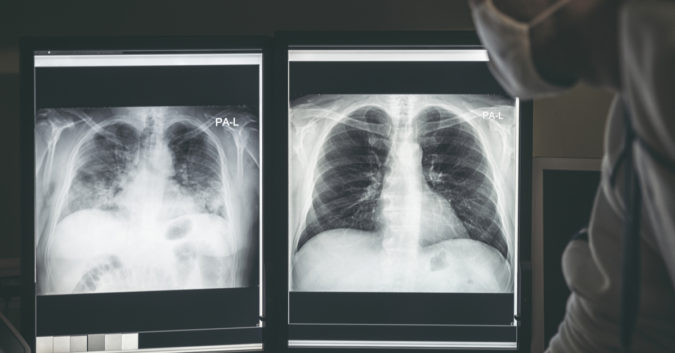Could the lung damage caused by COVID-19 be worse than the damage caused by chronic smoking? Texas trauma surgeon, Dr. Brittany Bankhead-Kendall, believes that just may be the case.
On Twitter, Bankhead-Kendall shared several anonymous patient X-ray images comparing post-COVID-19 lungs to those of a chronic smoker’s lungs, writing:
“Post-COVID lungs look worse than any type of terrible smoker’s lung we’ve ever seen. And they collapse. And they clot off. And the shortness of breath lingers on… & on… & on.”
A professor of surgery at Texas Tech University, Bankhead-Kendall has seen and treated thousands of COVID-19 patients since March 2020. Her recovering patients are still being closely monitored, going for check-ups and taking regular chest X-rays. Months after most symptoms have disappeared, many of her patients are still returning worrying X-ray images.
Because COVID-19 is still relatively new, the study of its long-term effects is still in its infancy. More data from over longer periods of time is still needed. But so far, the trends — and the X-ray images — seem troubling.
Long-Lasting Lung Damage
The idea that COVID-19 can lead to long-term lung damage isn’t new. Researchers like Johns Hopkins’s Panagis Galiatsatos, MD, MHS, who have been studying the respiratory illness since the outbreak in the United States, first started noticing the trend in April 2020.
According to Galiatsatos, COVID-19, the disease caused by the new coronavirus, can lead to certain lung complications like pneumonia and acute respiratory distress syndrome (ARDS). COVID-19 can also cause sepsis — a life-threatening condition in which the body’s response to infection damages its own tissues, potentially leading to septic shock.
Galiatsatos states:
“Lungs, heart, and other body systems work together like instruments in an orchestra. In sepsis, the cooperation between the organs falls apart. Entire organ systems can start to shut down, one after another, including the lungs and heart.”
Conditions like sepsis and ARDS can be fatal, and often patients who survive and recover have lasting pulmonary damage, including intense scarring.
Bankhead-Kendall has seen the scarring first-hand. According to her, patients who were diagnosed with COVID-19 — even those who presented as asymptomatic — show a “severe” chest X-ray 70-80% of the time.
“There are still people who say, ‘I’m fine. I don’t have any issues,’” Bankhead-Kendall reported to CBS New Dallas. “And then you pull up their chest X-ray and they absolutely have a bad chest X-ray.”
In the X-ray images Bankhead-Kendall shared with CBS Dallas, healthy lungs appear clean — no lines, no whiteness inside of the lungs, and blackness, which, in chest X-rays, is air. Beside the first image of the healthy lungs, an X-ray of a smoker’s lungs shows a series of incongruous white lines, which indicate lung scarring.
In the third image, a patient’s lungs post-COVID-19 appear almost entirely clouded by whiteness — covered in scars that crisscross and run the entire width and length of the lungs.
The X-ray image of post-COVID-19 lungs provided by Bankhead-Kendall looks strikingly similar to chest X-rays of patients living with asbestosis.
Asbestosis: Lung Scarring Caused by Asbestos
Once hailed as a mid-twentieth-century “miracle mineral,” asbestos exposure is now known to be the cause of several diseases, including mesothelioma, asbestos-related lung cancer, and asbestosis.
The result of breathing in microscopic asbestos fibers, asbestosis is marked by the painful scarring of a patient’s lungs. Once asbestos fibers have entered the body, they can settle inside one or both of the lungs. Because these fibers are so strong and durable, the body is not able to break them down — so they remain permanently in the lung where progressive scarring and damage continues over a series of years or decades.
Asbestos fibers cause lasting damage to the lungs by irritating healthy tissue. But unlike COVID-19 lung damage, which, while extensive, may potentially reduce over time, asbestosis is an incurable, life-long disease.
The scars caused by asbestosis thicken and harden over time, causing lungs to stiffen and making breathing extremely difficult and painful. Once diagnosed, asbestosis victims often find themselves strapped to oxygen tanks for the remainder of their lives.
Only a year into the COVID-19 pandemic, it’s still far too early to declare that those who developed the disease will make a full recovery from any and all lung damage. Still, the images of post-COVID-19 lungs produced by Dr. Bankhead-Kendall are striking in their similarity to chest X-rays of asbestosis patients.
Lung-scarring, whatever the cause, often leads to long-term breathing difficulties and can affect one’s ability to return to full strength and conditioning.
Recovery From Long-Term Lung Damage
Galiatsatos notes that “recovery from lung damage takes time.” Just like when the body experiences a wound from a cut or a scrape, the wound must first seal and scar. As with skin, the scars on one’s lung tissue can take time to recede.
Over time, however, it is possible for lung tissue to heal — though this process can take several years or longer, depending on the extent of the lung damage and a person’s overall health.
With time, scarring may go away and patients who are post-COVID-19 may ultimately return to their lung-function levels pre-COVID-19. Patients recovering from the viral disease should be prepared for ongoing treatment, tests, and therapy to help move that process along. For patients living with asbestosis, the scarring will never heal.
As for Bankhead-Kendall, she wants everyone to take the COVID-19 pandemic as seriously as possible: “Even if you survive, you still may be left with some severe complications that make it very hard for you to go back to your baseline functioning.”
